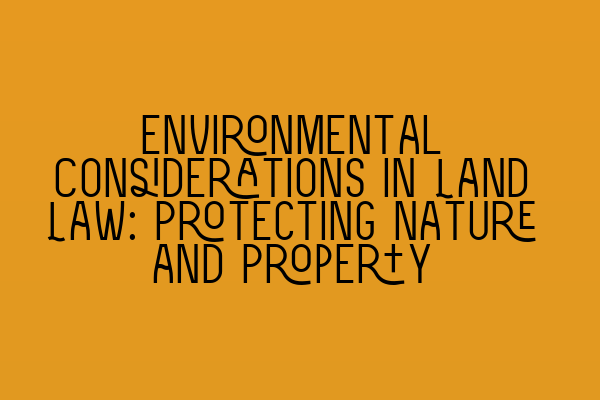Environmental Considerations in Land Law: Protecting Nature and Property
As the global community becomes increasingly aware of the devastating effects of climate change and environmental degradation, the importance of incorporating environmental considerations into various aspects of our lives has become more apparent. One crucial area where these considerations are essential is in land law, where the protection of both nature and property rights is of utmost importance.
In this article, we will explore the significance of incorporating environmental considerations into land law and highlight some key ways in which nature and property can be protected.
1. Conservation Areas and Natural Habitats
Conservation areas and natural habitats play a vital role in preserving biodiversity and the natural environment. These areas are legally protected to prevent unauthorized development and activities that may harm flora and fauna. It is important for property owners and developers to be aware of the existence of such areas and understand the restrictions and obligations that come with them.
For instance, if you are considering purchasing a property located in a conservation area, it is crucial to understand the limitations on alterations and developments that may affect the character and appearance of the area. By doing so, you can ensure compliance with environmental regulations and avoid potential legal issues.
2. Environmental Impact Assessments
In many cases, property development projects have the potential to significantly impact the surrounding environment. To address this, environmental impact assessments (EIAs) are conducted to evaluate the potential environmental effects of proposed developments.
EIAs take into account factors such as air and water pollution, biodiversity, noise levels, and waste management. These assessments help identify any potential negative impacts and propose measures to mitigate and minimize them. They are crucial in ensuring that property development strikes a balance between economic growth and environmental preservation.
3. Easements for Environmental Purposes
Easements are legal rights that allow one party to use or access another party’s property for a specific purpose. In the context of environmental protection, easements play a significant role in preserving natural resources and biodiversity.
For example, an easement may be granted to an environmental organization, giving them access to a piece of land for the purpose of conducting ecological surveys or conservation activities. These easements ensure that designated areas are adequately protected, even if the ownership of the land changes hands.
4. Sustainable Land Use Planning
Sustainable land use planning aims to optimize the use of land resources while minimizing negative environmental impacts. This approach involves considering factors such as soil quality, water resources, and ecological networks when making decisions about land use and development.
By integrating sustainable land use planning principles into land law, we can promote environmentally-friendly practices, such as developing green spaces, promoting renewable energy generation, and implementing efficient water management systems. These measures not only protect the environment but also enhance the value and desirability of the properties involved.
Conclusion
Incorporating environmental considerations into land law is paramount in protecting both nature and property rights. Conservation areas, environmental impact assessments, easements, and sustainable land use planning are just a few examples of the mechanisms in place to strike a balance between development and environmental preservation.
At SQE Property Law & Land Law, we understand the importance of environmental considerations in land law and are committed to providing expert advice to property owners, developers, and investors who wish to navigate the intricacies of this complex field.
If you would like to learn more about SQE preparation courses or SRA SQE exam dates, please check out our related articles:
– SQE 1 Practice Exam Questions
– SQE 1 Practice Mocks FLK1 FLK2
– SQE 2 Preparation Courses
– SQE 1 Preparation Courses
– SRA SQE Exam Dates
Feel free to contact us for any inquiries or assistance you may need. Together, let’s protect nature and property for a sustainable future.
